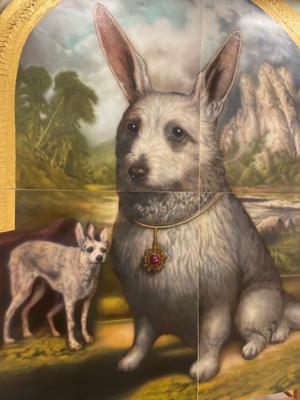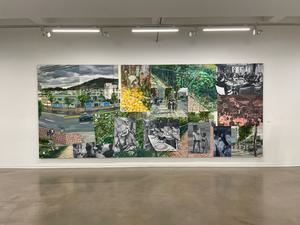Note 73 The note that begins the book
Following the publication of In the Wake, many people asked me about the process of writing an academic book that speaks to and beyond the academy. More specifically, people wanted to know about the form, and also about the first chapter, “The Wake,” which begins in the register of the autobiographical with my recounting the deaths, in close succession, of three members of my immediate family between May 2013 and February 2014. It was an ethical decision to include them because while I was reading and writing and thinking about Black people being murdered and about what we make in the face of all that structural violence, I was in the midst of so much personal loss. I thought that this loss also needed to be on the page explicity, not just implicitly in the ways that, whether one admits it or not, one is oriented to one’s work from the location of the body and all that that may mean.
It is the note that begins that book.
This must be a clip only, the title says there is 10 more minutes.
Hyuga on pop art, op art, primary structures etc. An urban kind of art, she says. Perhaps I’ll find later that the more technical term should actually be “comics” (in the case of Lichtenstein) but still, a memorable turn of phrase.
Be感覚 28
The title of a show at MEM featuring Tokuko Ushioda, Shigeo Gocho, Yoshitaka Saji, Masao Sekiguchi, Kazuto Miura. Maybe apart from my essay on Otsuji, this is one of the few times that the term “straight photography” has appeared in the public sphere of photography discourse in Japan?
Includes a talk with Iizawa Kotaro, not a surprise!
I really like the way he deals with the critique of Rirkrit Tiravanija’s work in terms of being “Thai,” when in his case that category is barely meaningful. Teh is dealing very handily with the pressures of the contemporary art market and museum structure for artists to be easily identifiable by nationality, especially when they come from South or Southeast Asia.
“Can this artist—born in Buenos Aires, trained in Toronto and Chicago, transposing his New York apartment into a Gennan institution—really be communicating there only as a Thai? Does an artist’s every move carry an overriding ethical obligation to speak from or to their national polity of origin?” 8
“But as we will see Thainess—as much as any national identifier, and probably more than most—is less a biological fact than a performance, a slow and convoluted becoming.” 9
Detail of a kind of strange painting I saw in Seoul. Laughed out loud in the gallery:

And this very nice one by Choi Gene-uk / 최진욱, the realism guy:

Asada Akira wrote this very nice review of the show here, includes an interesting tidbit that Sekula lined up the Kanikosen next to this right-wing manga from the 1990s called “On War” (小林よしのりの『戦争論』) which itself seems like a very interesting phenomenon.
アラン・セクラの作品は、コンセプトもプレゼンテーションも単純すぎるものの、横須賀の米海軍基地の兵士の写真と水産高校の生徒の写真を並べたり、小林よしのりの『戦争論』と小林多喜二の『蟹工船』を並べたりする正攻法の展示で愚直な批判的啓蒙に徹したところをかえって評価すべきかもしれない。
Gabriel Orozco question: he wants to know how artists on tje left were split, who went for military and imperial art, was there something like degenerate art, etc. This os a story that we do not know in English. And we do know the story in German say. I started to talk about tenko, Jelena’s book etc. Maybe there is something done in intellectual history or literature but not so much art?
A concept that Sasakubo Shin was talking about at his gig. Seemed to be about the idea that in certain indigenous cultures in brazil, when you talk about an experience of an animal, you become that animal. Felt relevant to subject object relationships, etc.
“Many critics of anthropocentricism have mistakenly perceived that the problem of our time is anthropocentricism rather than a failed praxis of being.” p 15
“I take it that any “art history” worth the name is a story of the present of past conjunctures of art (creation, consumption, criticism, infrastructure). It is therefore always a provisional genealogy of the relation between “art” and “society,” that is, the irreducible dialectic of the art form (and the immanent relations that constitute it as an object) and the social form (and the immanent relations of conflict that animate it). I take “art history” to be an endless critical revision of successive presents of past constitutions of the “art and society” relation.”
“I suppose a lot of my work in the last ten years has been exactly about how to theorize and conceptualize identity and identification which holds these two things together. I mean, the closest that I can come to it is to say that, of course, all enunciation is positioned. Without positioning, there is no meaning. You have to take up a position. If we believe in the infinite semiosis of meaning, no position is final. It’s a question of how to think the need for a positionality that is not final, what a not fully closed position is.”
From the Trajectories book p 373
two particles, photons i think? one is visible, one is not. they are called ‘entangled’ or ‘coordinated’ but i obviously like entanglement so much better. if you measure one, you know something about the other. learned this from J
Real hatake whose purpose is just to be looked at. 修学院離宮
We’re not dealing, needless to say, with a recipe or prescription. (“Painter, be as narrow-minded as Matisse …”) We’re confronting one of the paradoxes of modernity: that those who are surest they can speak to modern life almost invariably reproduce nothing but clichés about it; and that a few—a very few—of those holding modernity (rightfully) in contempt, but (wrongfully) thinking art might offer a way out of it, end up, poor devils, with the feel of the modern issuing from their brush.
In speaking to Okinawans, for instance, you would probably have to begin by marking your position as a member of Japan proper. But, as soon as you do so, you would probably have to consider another question. Is this distinction between Okinawa and Japan proper itself, not discriminatory? But, then, is it justifiable to include the Okinawans and yourself under the general category of the Japanese? I am sure more questions would arise. So, this initial marking does not confine a person to that position at all. Rather it is a step to be taken in order to realize that the position you hold is internally fragmented, far from being a stable closure, and in fact is open to multiple commitments and multiple contexts. It is necessary to mark your position in order for you not to be contained by it.
Sakai in dialogue w Stuart Hall in the Trajectories book, p 377
a thought that came to me after meeting T
Ahmed talks about the work of Sexologist Havelock Ellis, which I think has some nice resonances with Domon’s ideas of “aberration” and so on: “An aberration can refer to ‘‘the act of wandering from the usual way or normal course,’’ or even to a ‘‘deviation from truth or moral rectitude.’’ The same-sex orientation thus deviates or is off course.”
“It was only when artists recognized the site of art as socially specific that they began to oppose idealism with a materialism that was no longer phenomenologically-and thus still idealistically-grounded in matter or the body.”
Why set African photography against a Euro-American theoretical canon that we thereby reinforce when we now have the benefit of two decades of work on photography in East, Southeast, and South Asia; Australia; Latin America; and the Middle East? When do we stop treating these “other” photographies as exceptions that challenge the same old rules? This raises the question: Why “African” photography? What holds that category together? Might the Chinese photographers in Mozambique have more in common with Indonesian Chinese photographers than with Nigerians embellishing their clothes digitally? Might these latter individuals have more in common with Australian Aboriginal communities using cell phones to make ancestral connections than with colonial photographers in South Africa? What is the basis of the categories by which we divide up our scholarship and put practices into relation, and how does photography as a mobile and global technology challenge these boundary-making practices? I’m not suggesting Africa doesn’t matter as place and idea in these photographies, but when and how does it matter, and when are other connections salient?
From the discussion on Ambivalent. I have the PDF of the book now